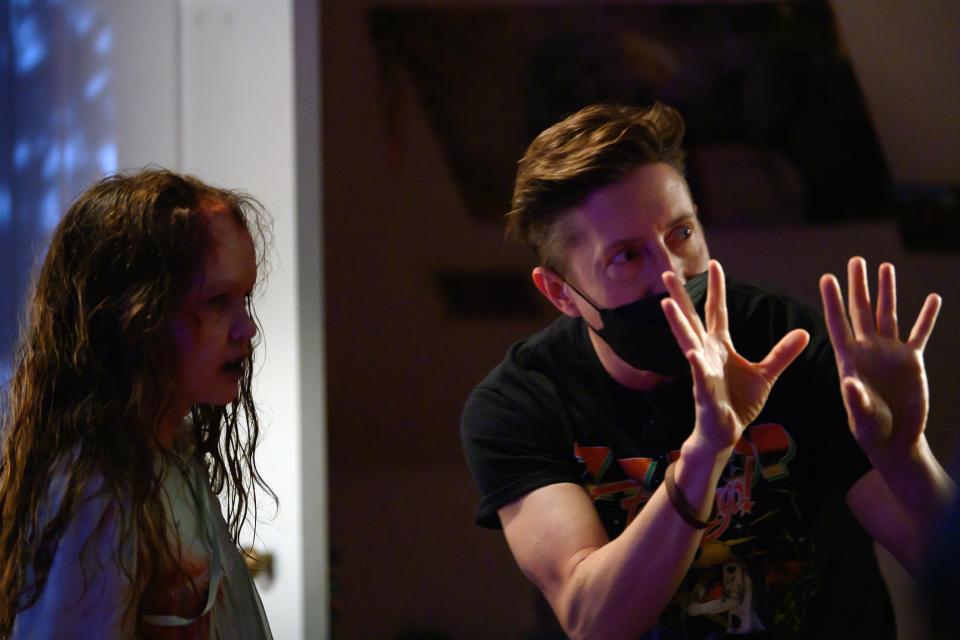Pazuwho? In Eerie Sequel ‘The Exorcist: Believer,’ It’s David Gordon Green Who’s Seemingly Possessed by the OG

How does a director live up to the memory of a classic? It’s a challenge to which David Gordon Green previously rose with his trilogy of sequels to John Carpenter’s “Halloween,” and now, with Blumhouse‘s “The Exorcist: Believer,” he takes on continuing what many believe to be the greatest horror movie ever made. According to Green, the goal is never to compete with the original but to work in its tradition and move the story into a new era.
“I’ve studied ‘The Exorcist‘ for many years,” Green told IndieWire. “There’s no way that a sequel, reboot, or remake can ever be as profound and shocking as when that subject matter and execution was unleashed on the culture in 1973. But we can continue the story of characters we love and meet them in a contemporary world where the effects of the events in Georgetown 50 years ago mirror the effects of the success of that film on our outside world. I thought that would be fun to explore.”
More from IndieWire
It’s certainly fun for the audience, as “Exorcist: Believer” immediately evokes the atmosphere of director William Friedkin and author William Peter Blatty’s original right from the opening shot. After the obligatory studio and production company logos, Green cuts to a haunting image of two dogs fighting on a beach that recalls a similar image from the first film’s prologue and establishes the location (Haiti) via the same font made iconic back in 1973. The subsequent scenes establish the visual and aural rhythms that will carry on throughout the film as Green juxtaposes moments of extreme violence and terror with straightforward, almost documentary-like observational sequences.

While the image of the dogs is a direct quotation from Friedkin’s original, it’s a rarity; for the most part, the original’s influence manifests not in the form of imitation or homage but on a deeper, more profound level, where Green’s film seems to have fully absorbed the DNA of “The Exorcist” and is now applying its techniques in an organic way that makes “Believer” a worthy successor to Friedkin’s masterpiece. One key to the power of the prologue — and by extension the movie as a whole — is the way Green applies the original film’s principles when it comes to sound design. “Friedkin, along with his brilliant editing team and sound designers, brought [‘The Exorcist’] an uneasy quality with jarring edits and harsh unsettling sounds that often don’t give the audience even a second to process the information before it moves on,” Green said. “The film doesn’t have the obvious reaction shots and thoughtful pauses at the end of a sequence, and we wanted to explore a similar psychological effect in our film.”
“The Exorcist: Believer” creates an almost unbearable sense of anxiety right from the beginning, and it’s an anxiety that doesn’t come from the plot; we’re as tense in scenes where nothing overtly horrific is happening as we are in the terrifying exorcism rituals involving the two girls whose demonic possession forms the crux of the story. “The Exorcist,” too, spends relatively little screen time on actual “horror” sequences and often cuts away from them before they’ve had a chance to fully register. After one of the movie’s most famous and shocking scenes, Friedkin cuts to a plain dialogue scene that’s almost totally lacking in atmosphere. It seems counterintuitive, yet the juxtaposition is what gives “The Exorcist” its power, as the coexistence of terror with the mundane generates an impression that the devil’s work is simply part of our everyday lives.
“Friedkin and [cinematographer] Owen Roizman had a vibrant, clinical style to their film,” Green said. “Study the scene with Chris and Detective Kinderman for an amazing long, slow, zoom lens sequence. We took that inspiration to heart for the first half of our film, but then, as the movie progressed, I began using movement and dolly more, pushing into the girls’ faces to enhance momentum and emotion.” The trick for Green was to replicate the deliberate pace of Blatty’s “Exorcist” screenplay without following it so closely that “Believer” would feel like a film from another era. “The slow-burn pacing of films from the ’70s that I do love so much has a hard time with the modern mass audience,” Green said. “We tried to find a middle ground that honored the cinematic language that came before us but gave room to evolve with our signature and update some of the pacing.”
Indeed, another strength of “Believer” is its unerring sense of how to balance its psychological and spiritual elements with the genre requirements; Green and cowriters Scott Teems, Danny McBride, and Peter Sattler expertly play the film’s serious consideration of religion against some rip-roaring set pieces, with each aspect of the structure informing the other in emotionally productive ways and broadening the original’s exploration of belief by expanding beyond Catholicism. Green was aware that the original’s power came largely from its sense of mystery — that not every image has a concrete, easily digestible meaning or connection to the narrative, which adds to the overall sense of unease. “The ambiguity of Blatty’s storytelling is hard to recreate with today’s audience that is looking for tight scripts and twists and logic and answers,” Green said, but he added that the challenge was part of the appeal. “That is something I was hoping to play with — to let our imaginations do some of the work.”
Universal Pictures releases “The Exorcist: Believer” in theaters nationwide October 6.
Best of IndieWire
Where to Watch This Week's New Movies, from 'The Exorcist: Believer' to 'Dicks: The Musical'
The Best Thrillers Streaming on Netflix in October, from 'Fair Play' to 'Emily the Criminal'
Sign up for Indiewire's Newsletter. For the latest news, follow us on Facebook, Twitter, and Instagram.
